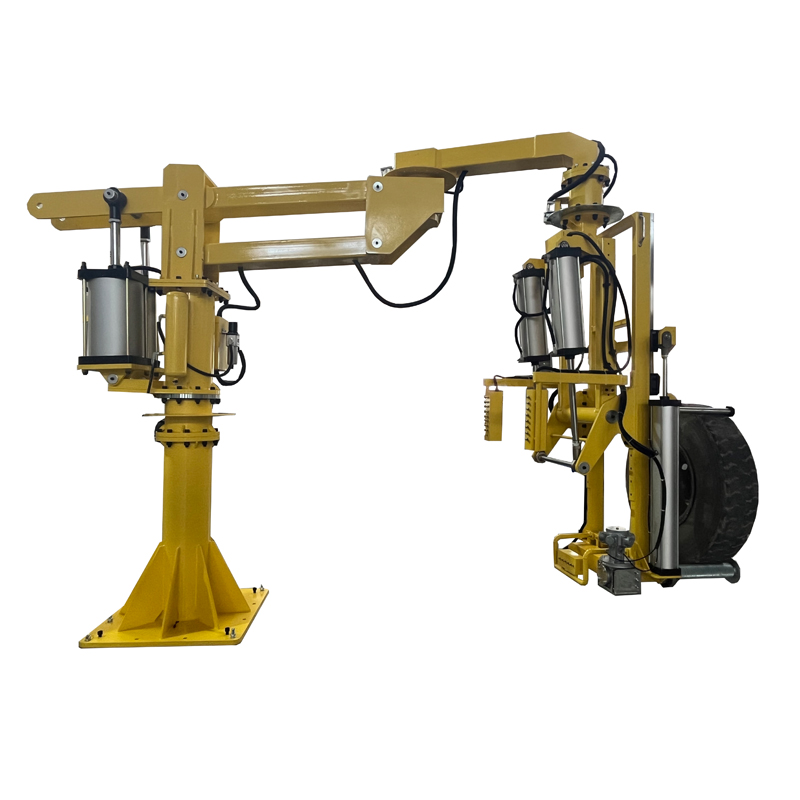The Ergonomic Zero Gravity Arm, more accurately called the Zero Gravity Arm or Force Balancing Arm, is an advanced industrial assistive device whose core design concept is to eliminate or significantly offset the weight of the load (tool, workpiece), allowing the operator to perform various operations with almost no effort. This device takes ergonomic principles to the extreme and aims to maximize operator comfort, efficiency and safety.
Core Principles and Features of Zero Gravity Arm
The reason why the Zero Gravity Arm can achieve the “zero gravity” effect is that it has a sophisticated balancing system integrated inside.
Weight Balancing Mechanism:
Pneumatic Balance: The most common form. An adjustable upward thrust is generated by compressed air in the internal cylinder to accurately offset the weight of the tool or workpiece connected to the end of the arm. The operator only needs to push or pull lightly, and the tool can hover and move freely in the preset workspace.
Spring Balance: Use the elastic force of a mechanical spring to balance the weight of the load. The structure is relatively simple, but it is usually suitable for lighter loads or fixed weight scenarios.
Servo electric balance: A more advanced and intelligent system. Through high-precision servo motors and force sensors, the tiny force applied by the operator and the weight of the load are sensed in real time, and the motor is accurately driven to generate compensation force. This system can provide the smoothest and most accurate power-assisting effect, and can even be programmed to achieve guidance or anti-sway functions for specific paths.
Multi-joint design:
Zero-gravity arms are usually designed with multiple joints to give them multiple degrees of freedom, allowing them to flexibly stretch, bend and rotate in three-dimensional space to adapt to complex working postures and reach narrow areas. This multi-joint design is also often called a folding arm.
Ergonomic interaction:
Handle/operating lever: The operator guides the tool or workpiece by holding an ergonomically designed handle or operating lever. The handle is usually integrated with function buttons such as tool start, lock, and fine-tuning.
Tactile feedback: The operator can directly feel the movement of the tool or workpiece and accurately position it with a natural feel, rather than relying on complex button operations.
Carrying end tools or fixtures:
The end of the zero-gravity arm is designed to quickly install various tools (such as tightening guns, grinders, drills, dispensing guns, etc.) or customized fixtures (for grabbing workpieces). This means that it is not just a handling device, but an “extension” of tool operation.
Mounting method:
It can be column-mounted (fixed to the ground), wall-mounted (fixed to the wall), or suspended (mounted on the top track system to achieve a wider range of X-Y plane movement).
The significant advantages of zero-gravity arms (i.e. the embodiment of “ergonomics”)
Complete elimination of labor intensity:
This is the core advantage. The operator does not need to bear the weight of the tool or workpiece, as if they are “weightless”. This means that heavy tools can be operated or heavy objects can be carried for a long time without fatigue or muscle strain.
Significantly reduce the risk of occupational diseases and injuries:
Eliminate repetitive strain injuries (RSI): Reduce repetitive stress on the arms, shoulders, and back, and prevent occupational diseases such as tenosynovitis, frozen shoulder, and lumbar muscle strain that are related to long-term operation of heavy tools or lifting heavy objects.
Prevent accidental injuries: Avoid accidents such as smashing and sprains caused by falling tools, unstable operation, or physical exhaustion.
Improve working posture: Allow operators to operate at the most comfortable and natural working height and angle without bending, overstretching, or maintaining unnatural postures, thereby reducing pressure on the spine and joints.
Improve operating accuracy and product quality:
Stable grip: Since the weight of the tool is offset, the operator can control the tool more stably and accurately, reduce shaking and deviation, and thus improve the accuracy and consistency of processing or assembly. For example, it can ensure more stable torque output when tightening screws and smoother paths when grinding.
Reduce scrap rate: Precise operation reduces workpiece damage or processing defects caused by human error, reducing scrap rate and rework costs.
Improve production efficiency:
Speed up the pace of work: Operators can move tools or workpieces faster and more smoothly, shortening the single operation time and improving the production rhythm.
Extend effective working time: Due to reduced fatigue, operators can maintain concentration and work efficiently for longer.
Single person completes the task: Many heavy tools that originally required the cooperation of multiple people to move or operate can now be completed by a single person independently.
Improve work flexibility and comfort:
The operator’s attention can be fully focused on the task itself, rather than how to support the weight of the tool, thereby improving concentration and problem-solving ability.
The multi-joint design enables it to flexibly avoid obstacles and work efficiently in complex working environments.
Typical application scenarios
Zero-gravity arms are widely used in industrial fields that require long-term operation of heavy tools or frequent handling of small and medium-sized heavy objects:
Automobile manufacturing and assembly: Tightening gun operation (wheel bolts, engine parts), chassis anti-rust gluing, body polishing and grinding, parts assembly.
Machinery manufacturing: loading and unloading of machine tools, precision assembly of heavy workpieces, drilling, tapping, grinding, and welding assistance.
Aerospace: aircraft skin riveting, drilling, and component assembly.
Home appliance manufacturing: tightening, assembly, and inspection tool operation on washing machine and refrigerator production lines.
Electronic product manufacturing: large display installation, precision electronic equipment assembly.
Workpiece handling and alignment: combined with customized fixtures, various small and medium-sized heavy objects can be handled and accurately aligned (such as battery packs and large glass panels on the production line).
Zero-gravity arms are powerful tools for achieving human-machine collaboration, improving employee welfare, and improving production efficiency and product quality in modern industrial production. They represent the future factory’s pursuit of an operator-friendly working environment.
